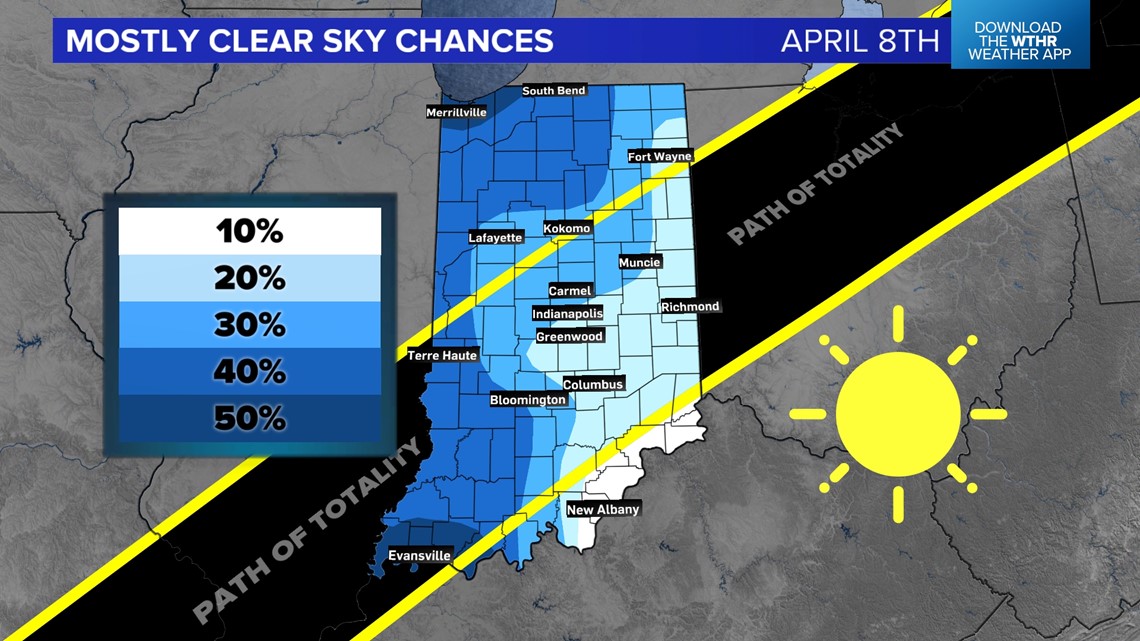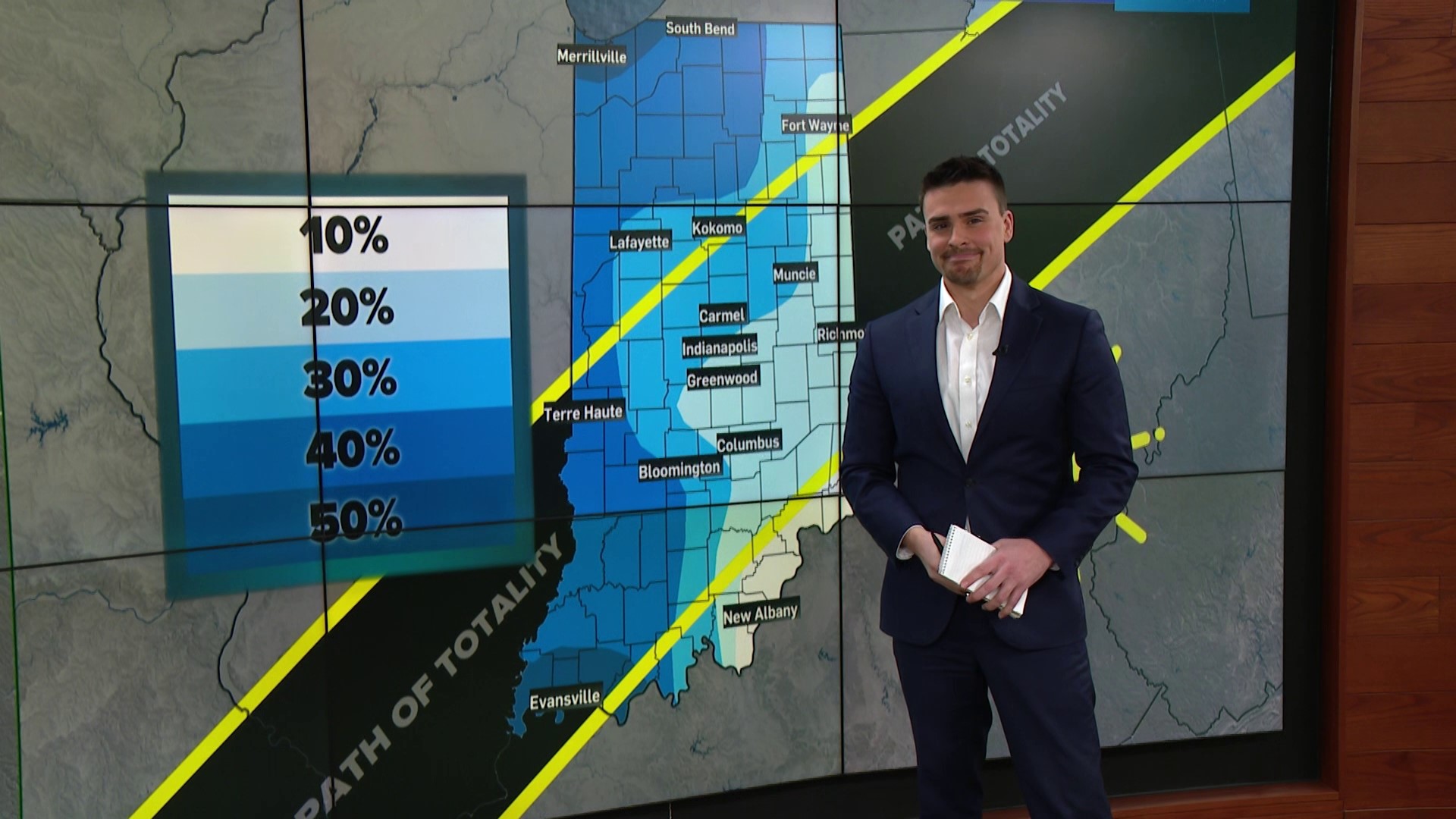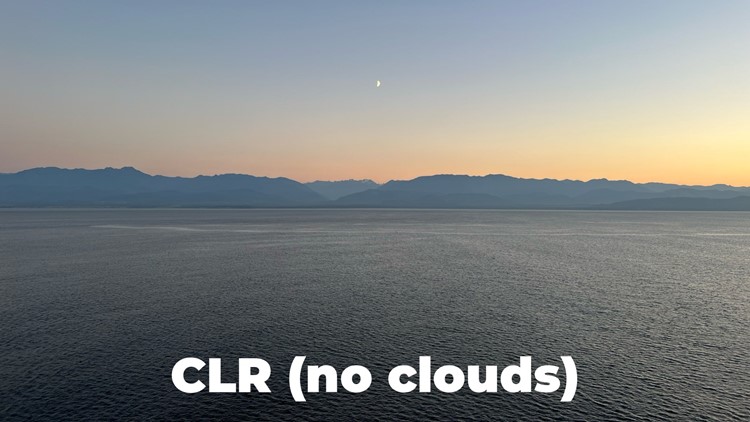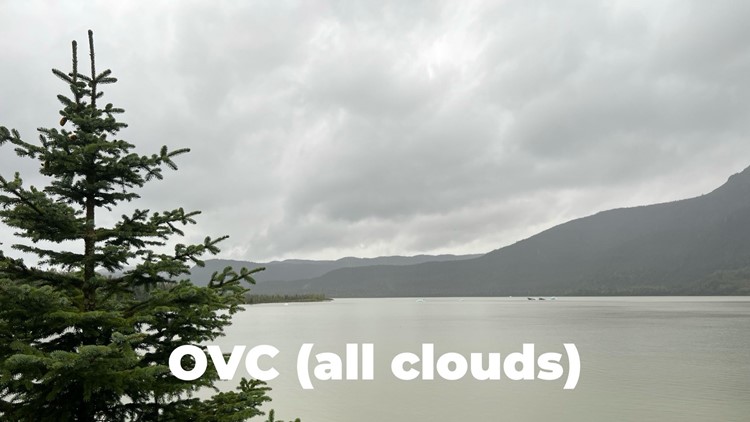INDIANA, USA — The last thing you want during a total solar eclipse is a cloud that blocks the view. Until we are about a week out from April 8th, we can use climatology to find the statistical chance of clouds across Indiana. Who has the best chance for clear skies? Who is mostly likely to get clouds?
If you are traveling to Indiana, this may help guide you on where you should plan to go to see the eclipse.
During the event, tap HERE to track clouds on our interactive satellite.
(If you want a deeper dive into cloud data across Indiana, scroll down for an extensive look at sky condition chances.)
What is the chance for clouds across Indiana on April 8th, 2024 around 3 p.m. EDT?
Climate data suggests the farther west you go, the better your chances are for clearer skies in Indiana.


This map shows the chance for clouds across Indiana. The higher the percentage, the higher chance of clouds based on climatology over the past 30 years.
This data set accounts for having a sky that is 75% or more clear from clouds. This may account for a few passing clouds, but generally the sky is mostly sunny. And you should be able to see the eclipse just fine, except for the chance that the one cloud in the sky is the one that floats in front of the sun for the 3-4 minute eclipse.
A few interesting notes...
- Lake Michigan starts to have the opposite effects on clouds. Cold waters and warmer air temperatures tend to produce fewer clouds. That's why the cloud chances drop a bit near Merrillville and Valparaiso.
- Eastern and southeastern Indiana have the highest cloud chances. Spring rain systems tend to pick up intensity and coverage over the Ohio River Valley bringing higher rain chances.
Deeper look at cloud data
How accurate is this information?
We looked through 630 cloud reports across Indiana – including 21 cities that have ASOS weather stations that have ceilometers or instruments that measure cloud coverage and heights. One thing to note, these ceilometers measure only up to 25,000 FT, which may miss some cirrostratus clouds closer above 30,000 FT.
We looked at data from the past 30 years from 1994 to 2023. We dissected this data many different ways.
Usually the past can give us an idea of what the future will bring, however, it is not a guarantee. Anything can happen on solar eclipse day. However, this data can help a family statistically find the best place in Indiana to watch totality.
Cloudy? What's your definition of clouds?
This is getting into some meteorological weeds. But let's go there!
The National Weather Service (NWS) breaks down their cloud observations into 5 categories. More specifically they break the sky down into 8 slices (or oktas) and see how many clouds fill the slices:
Note: We did not simplify fractions to keep the data simpler to compare.
- Clear: CLR (no clouds)
- Few: FEW (1/8 to 2/8 clouds)
- Scattered: SCT (3/8 to 4/8 clouds)
- Broken: BKN (5/8 to 7/8 clouds)
- Overcast: OVC (all clouds)
Cloud coverage NWS observations
So everyone has an opinion on what "cloudy" means. Some people consider that overcast, others would say you need at least the sky to be 50% filled with clouds, and then you have some folks in the middle.
So what are our specific chances for clouds using these NWS definitions?
Let's start with completely clear skies. This is hard to do in spring, but there is a small chance we don't have any clouds over parts of Indiana. Clear skies would be perfect for viewing the total solar eclipse.


(the higher the percentage, the higher the chance for sunny skies)
There is a much higher chance (30% and higher) in the medium blue zones including towns like Bloomington, Evansville, Terre Haute, and Valparaiso. Areas in white have a very low chance of completely clear skies, generally 10-19% chance of clear skies.
I can handle a cloud or two... What about having mostly sunny skies?
The chance goes up for mostly sunny skies when you can still allow 1/8 (12.5%) to 2/8 (25%).


(the higher the percentage, the higher the chance for sunny skies)
The sunny chances dramatically increase for northern, western, and southwestern Indiana. In fact there is a 50% chance of having mostly clear skies in the Region and around Evansville.
What are my chances for overcast skies? No sun breaks at all... No solar eclipse view?


(the higher the percentage, the higher the chance of clouds)
There is a pretty high chance that towns in central, eastern, and southeastern Indiana will be overcast. In fact, the chance is above 70% for overcast skies.
Does El Niño play a roll in cloud chances?
While looking through the numbers, there was a slight increase in cloud chances during El Niño April's. You may add a couple percentage points for cloud chances across the entire state of Indiana when you single out ENSO patterns.
CITY-BY-CITY LOOK AT CLOUDS
The following numbers are based on the chance of having a scattered, broken, or overcast sky (38%-100% of the sky is cloudy).
- Bloomington: 60% cloudy
- Brownsburg: 63% cloudy
- Elkhart: 59% cloudy
- Evansville: 50% cloudy
- Goshen: 50% cloudy
- Huntington: 50% cloudy
- Indianapolis: 74% cloudy
- Kokomo: 64% cloudy
- Lafayette: 67% cloudy
- Muncie: 69% cloudy
- Peru: 72% cloudy
- Shelbyville: 52% cloudy
- South Bend: 53% cloudy
- Terre Haute: 53% cloudy
- Valparaiso: 48% cloudy
So where should we go?
If you are strictly basing your location decision on cloud climatology, head west and southeast. Evansville, Vincennes, Bloomington, and Terre Haute may be your best chance for sunshine across Indiana.
Check back with the WTHR weather team closer to the total solar eclipse for a more specific cloud forecast based on current weather systems heading toward Indiana.











